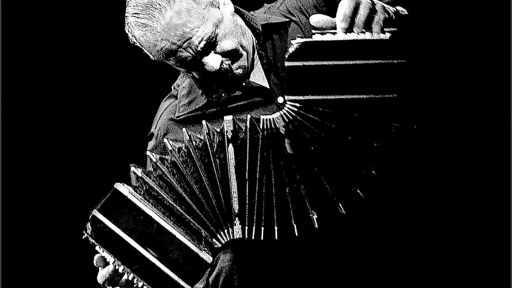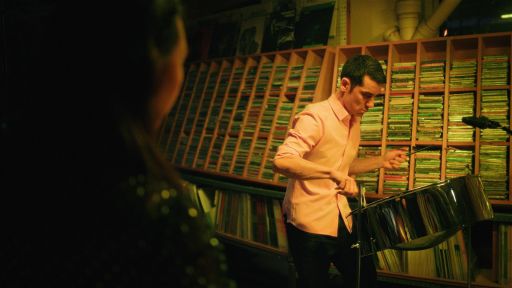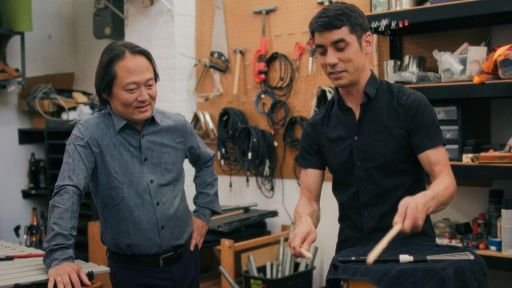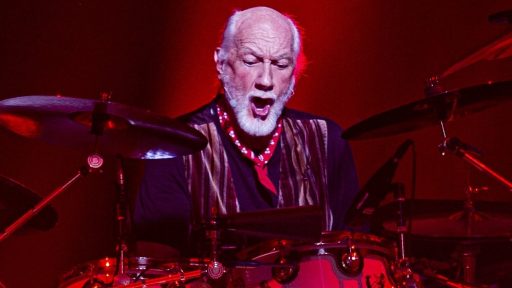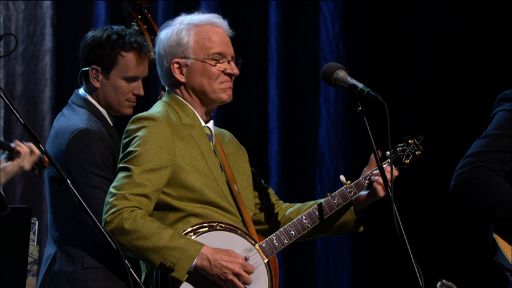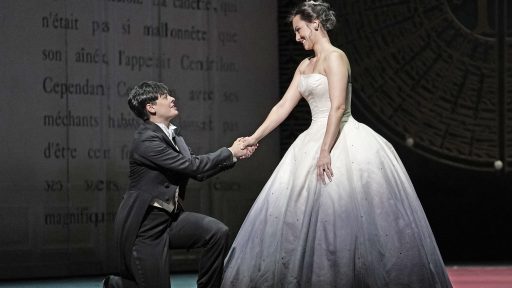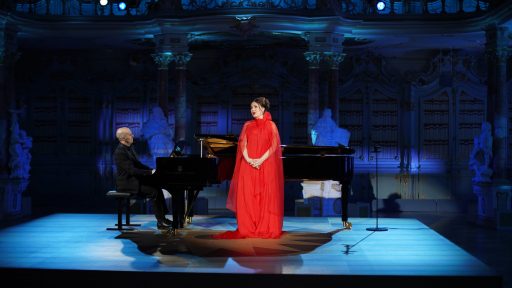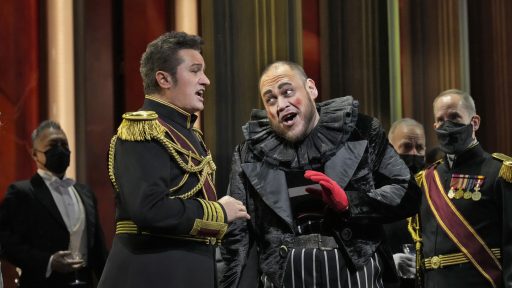TRANSCRIPT
♪♪ -Coming up on "Great Performances"...
I'm Scott Yoo.
Join me to spend a few surprising days with Andy Akiho, one of the most in-demand classical composers in the world today.
♪♪ Andy will show me his New York.
-We're in Crown Heights right now, in Brooklyn, and these are my favorite players.
-He's combining Caribbean, Asian, and modern jazz influences.
-What I'm really excited about is that we kind of have a found-sound drum set.
-"Found sound" meaning...?
-Literally finding things and hitting them.
♪♪ -Whoa.
[ Piano plays ] And creating a sound so uniquely his own... [ Muted piano chord plays ] ...I had to find out how he does it.
-Always want to be inspired by my environment, anything from this art form to visual artists, architects... -So, potentially, eating here today might affect what you write tomorrow.
-Yeah, I believe so.
-Next, on "Now Hear This," dive into the creative process of a composer like no other to see how Andy Akiho found his sound.
♪♪ ♪♪ Major funding for "Great Performances" is provided by... ...and by contributions to your PBS station from viewers like you.
Thank you.
♪♪ -I'm always on the lookout for exciting new composers, and, recently, one name kept coming up -- Andy Akiho.
♪♪ In just a few years, he's gone from a complete unknown to having works commissioned by major orchestras, and his instrument is the Trinidadian steel drum.
How's he doing it?
I went to New York to find out.
I lived in the city for years, but Andy would take me to places I'd never seen before as I tried to figure out the keys to his success.
We'd start in Sunset Park, Brooklyn, where I asked Andy to show me how he's building his new magnum opus, "Seven Pillars."
♪♪ ♪♪ ♪♪ Bravo, man.
-[ Chuckles ] Thanks.
-So you just -- is this something you just wrote, or did you revise this?
-Uh, yeah.
Yeah, I was just playing around, just improvising with some of the vocabulary I'm working on for this -- this new piece for Sandbox Percussion.
-Wow.
I mean, I guess it just comes out of your body, right?
You can't explain how you do it.
-Well, I mean, just...
I'm probably better at this than talking... -[ Laughs ] -...but just like, you know, as we talk, and it's, like, Just having a conversation with myself and with the instrument, you know, and then I love working in here because it's a playground of all the instruments, and it's going to be a different piece.
If I wrote this at home or just wrote it on the computer or wrote it by hand in a basement somewhere versus in this -- this space where I can play with the instruments and improvise.
-Wouldn't be as good, huh?
-Well, it would be different.
Maybe it's worse if I'm here.
I don't know.
But -- But it -- But it is as honest as I can be with it, you know?
-You know, I talk to young composers like yourself a lot, and a lot of them feel like they have pressure to create a new language, otherwise they're labeled as derivative.
And I was wondering, do you feel that kind of pressure, or does it come from somewhere else with you?
-I think, for me, it was extremely different, only because I'm not good at being derivative, like, I'm not good at listening to a song on the radio and go, "Oh, that's the 'D' minor," and play it on a guitar or piano or something.
I just -- I've never had that talent.
So that's -- I think that's why I came into composition so late in life.
You know, I was already in my late 20s, early 30s when I kind of really started this thing.
So, for me, it was just like, how can I -- how can I create something that I can share an experience with?
-So what instruments are you writing for with this -- this -- this piece, the "Seven Pillars"?
-Well, it's a lot of the traditional classical percussion instruments.
-Okay.
Like the vibraphone?
-Like the vibraphone.
And then what I'm really excited about is we kind of have a found-sound drum set or a multi-percussion found-sound -- -"Found sound" meaning...?
-Just, like, literally finding things and hitting them.
And if they sound good -- -So they're not instruments?
-I mean, I think anything can be an instrument, from paint cans to bottles to ceramic bowls.
-Can you show me what that is?
-Definitely, yeah.
Let's build something, you know?
-Okay.
-I just -- it's fun.
-Mm.
Oh, nice.
-Just got to take this out.
We don't want to break that, but...
Does it Sound cool?
Yeah, that sounds great.
-Mm.
Whoa.
♪♪ ♪♪ That's pretty cool.
So tell me about these.
-Yeah, this is a -- it's a brake drum, and, well, it's -- it's just a great instrument.
You know, it's very resonant.
It's used a lot in calypso, in soca, in Trinidad, and a lot of my roots are from that music.
And it's also used a lot in -- in new music.
-How did you get into calypso and Trinidadian music?
-Yeah, I started that in college, and then after I graduated undergrad, I got really obsessed with it, and I went to Trinidad a lot and played with the big steel orchestras.
And then I taught here in Brooklyn.
We used to teach a big steel orchestra.
-Steel orchestras?
In a steel-drum orchestra?
-Yeah, like, a full steel band.
-Really?
You know, so instead of the violins, you have the tenor pans, like, the soprano voice of the orchestra, double seconds, like the violas, double tenors, you have cello pans, bass pans, you have six -- you know?
And that was, like, my first time really writing with pitches.
From there, I wanted to grow out, like, kind of expand and write for other instruments, and then that's how I kind of morphed into being a composer.
-Wow, That's really cool.
-Yeah.
Speaking of found sounds, like, I think the roots of this, you know, I'm not a historian or anything, but I -- you know, I know that all these kind of things kind of grew into this, and there being a ton of 55-gallon oil drums in Trinidad, they got the idea to -- to pound it in.
It used to actually go this way, convex versus concave, and -- -Okay, so this is a steel drum that's been cut?
-Yeah.
-And this used to be the top and used to be flat?
-Used to be flat, and this was down to the ground.
-And they bang it -- they bang it enough so that it goes down?
-Yeah, and they used to do all that by hand.
Now they have machines.
It's, like, a hammer machine to get it, and then you got to shape the bowl.
They have a very specific kind of pattern, you know?
So this is circle of fifths, right?
This is like a middle "C" in the keyboard on the piano, right?
"G." "D." "A."
"E." And just goes up.
Chromatic, you know?
And then the octaves are here.
So you get about 2 1/3 octaves on this instrument.
-So when you write for cello for the first time or violin for the first time, would you combine it with steel pan in order to sort of be "at home"?
-Yes.
-A little bit?
-Yeah, that was -- that was kind of my start, writing for my friends, and it was just a natural process, being a composer, performer, really, primarily a performer.
I wanted to write more for this instrument so I could perform with my friends, you know?
-That's fantastic.
You're building -- You're building the catalog for your instrument.
-[ Chuckles ] Yeah.
Yeah.
You wrote something for violin and steel drum, right?
-Yes.
-Let's play it.
-Oh, awesome.
-Alright.
♪♪ ♪♪ ♪♪ ♪♪ ♪♪ ♪♪ ♪♪ ♪♪ ♪♪ ♪♪ ♪♪ ♪♪ Next, Andy took me to Greenwich Village to The New School to meet his collaborators on the "Seven Pillars" project, the Sandbox Percussion quartet.
-Maybe we'll do accidentals first.
-The quartet is Victor Caccese... -Yeah, there's all these -- That's also very loud.
-...Jonny Allen.
-It's, like, years of... [ Chuckles ] -...and Terry Sweeney and Ian Rosenbaum.
-These three, I'm hoping for kind of, like, a zigzag, like, kind of slightly out from under... -They're working with director Michael McQuilken... -Same thing.
All the stands are, yes, stage right.
-...to invent a lighting program for the piece.
-Yeah, exactly.
-So, it's called "Seven Pillars" because there's seven major movements where they all play, all four of them, and then four of the movements are going to feature each individual as a soloist.
And this is an 11-movement work.
It's 80 minutes long.
-Phew!
You guys memorized 80 minutes of music?
Crazy.
-We're trying to.
-Awesome.
-[ Chuckles ] -And so we're doing -- to top it all off, we're doing 11 music videos with 11 different directors.
And then we have this live show that's completely choreographed by Michael McQuilken, and he's putting all these lights that are controlled by the group.
So it's self contained.
-Yeah, we're basically programing this iPad with a million light cues that they're also triggering from stage in addition to the 5 billion notes that they've memorized for the thing.
So they're having to add even more to their brains.
Actually, it's a perfect moment that you arrived because I just finished the lighting design, or at least the first stab at it for the fifth movement.
And I'm hoping red works for you, given the tonality of the fifth movement?
-Yeah, that works.
-Okay.
-That's great.
-So we've been in red prior to this moment for about seven minutes, and my hope is that we can build this piece to a hopefully very unexpected light move based purely in color.
Shall we dim the lights and give it a try through those first few cues?
-Yeah.
-So top of the piece, we'll stay in red.
I have basic ideas where these cues go, but the big one that we kind of need to lead up to that we should decide together is when we go to this.
Nice.
-That has such a contrast.
-Yeah, yeah.
Exactly.
Opposite end of the color wheel.
And then we go to a lot, crazy.
And then -- -Okay, okay.
-And then a -- because the end is so resonant of this piece, we should hit the bright resonant followed by a slow blackout, which is happening now, slowly, because there's so much ringing on the...vibes.
Everything's ringing at that point.
-Yeah, I mean, in the coda, you know, they're in unison for a while.
Like, what's the -- -Like, "J"?
-"J's" right when you get into the coda, right?
-J" is the unison.
So we need -- we need something even bigger than that.
Like, when do the kicks come in?
Is that -- that "K" or "L"?
-Come in after.
-Uh-huh.
-That's "L," yeah.
-That's letter "L," right?
So the cannons, like, the -- the bass drum cannons.
-Yeah -That's -- That's a perfect moment, I think.
♪♪ ♪♪ ♪♪ ♪♪ ♪♪ ♪♪ ♪♪ -Dope, dope.
Perfect.
So that was -- the -- the other cues that we talked about are going to be so easy to nail if you nailed that so easily.
So let's -- let's decide where these other cues go, and then I can just let you guys own it and run with it.
-Next, Andy wanted to take me to Two Bridges, one of his old neighborhoods, and a key place in his formation as a composer.
♪♪ -We're in, like, a subset of Chinatown.
It's called Two Bridges, but I feel like this is even more Chinatown than Chinatown, 'cause it's -- not all the tourists come right through here.
-Ah.
-This is, like, the neighborhood, you know?
A lot of my roots and inspiration are from here.
I also found out that John Cage used to live here.
-And was he an influence for you?
-Oh, huge influence.
Like, especially his prepared writing and his percussion writing, obviously.
And then there's this Downtown Music Gallery.
This is an amazing, amazing record shop, like all the really avant garde jazz, like fusion and everything that I've been influenced by, I can find in here.
Let's -- Let's check it out.
-Okay.
-[ Chuckles ] I love this place, man.
-You know, I've never heard of half of these people.
-I think I haven't heard of 80%, but that's what's exciting, too, discovering new -- -So you just buy random stuff?
-Sometimes.
Or if Bruce recommends something.
-Is he the owner?
-Yeah.
-And every now and then, I'll come in with something specific, and he'll have it, too.
I remember hearing "Peace Piece" for the first time, Bill Evans, and came in here, like, the next day, and he's like, "Oh, man, we have that one."
I was just so happy 'cause it's one of my favorites.
-So which albums did you buy here that -- that changed your life?
Definitely that Bill Evans "Peace Piece" album.
Got some Thelonious Monk albums from here.
-Mm.
-A couple of the John Zorn.
-And I even found a Philip Glass one here that was an old classic... -Hm.
-...that I actually wasn't aware of.
-Have you ever seen your recordings in this store?
-When I moved here [chuckles] I came down here, and I was just -- I was blown away 'cause I was like, "Oh, this is my kind of store."
-Yeah.
-And I just randomly looked and saw my CD at the time, my first CD.
I felt like, "Okay, I was meant to move on this street."
-This is your family right here.
-Yeah, yeah.
-It's kind of fitting that you lived here.
-Yeah, I mean, I lived all over New York, but when I moved here, it was when I was really becoming a composer, not just a performer.
I really started defining my voice here in this neighborhood.
It's where I wrote my first kind of composition, and that was "Aka."
-That's an early piece?
-Very early.
-So is "Aka" piece that you still play today?
-Yes.
It's -- I think every time I play it, it's a different instrumentation.
-Hm.
-Anything from a solo to full orchestra.
-Nice.
-We're going to hear that one today?
-Oh, yes, we'll hear the trio version -- Kenneth Salters is going to play drums, and Linda Oh on bass.
♪♪ ♪♪ -I was starting to get a picture of Andy's creative process, using bits of jazz, classical and alternative music as his inspiration.
♪♪ ♪♪ ♪♪ ♪♪ ♪♪ ♪♪ ♪♪ ♪♪ ♪♪ We left Chinatown and walked a few blocks up to the Bowery to Andy's favorite sushi restaurant, Cagen.
It's a food, I'd find out, that Andy has a special connection to.
♪♪ ♪♪ ♪♪ ♪♪ That's the real deal.
-Yeah.
[ Chuckles ] -Apparently, it's a root and it's really easy to steal and it's really valuable so they have guards.
It's pretty cool.
-Wow.
It's amazing.
-Akiho is a Japanese name.
So did you grow up eating this?
-I didn't grow up too much with my Japanese culture until I was about 26... -Hm.
-And I really got to know my father.
He had a sushi restaurant.
-Really?
-Yeah, I'm half-Japanese.
-Like, you're half-Japanese, too, right?
-That's right, sure.
My mom's Japanese.
-I ended up becoming a sushi chef at his restaurant... -Really?
-...for about a year, yeah.
-Steel-pan-drum composer and sushi chef.
-Yeah, and he had live comedy one night, he had live jazz another night, and this is every week.
And so I would sit in with the jazz band every -- -Really?
-Yeah, it was a jazz trio.
Amazing group.
-That's kind of the ultimate expression in fusion, right?
Here you are, a half-Japanese person, and you're working at a Japanese restaurant in Washington, but you're also playing the most American art form possible in jazz.
-Yes.
-Wow, look at that.
He makes the best nigiri.
-Wow.
-It was a really inspiring year.
I mean, that was an extremely pivotal year in my growth as an artist, you know, really getting in touch with my Japanese roots to see, like, his kind of artistry and incredible sushi chefs doing it at the highest level.
It just really inspired me musically to seeing another art form.
-Right, that's not -- this is not flipping burgers.
This is an -- this is an art form in and of itself.
-Oh, definitely.
Definitely.
I think it takes.
A lifetime to really -- to do it right.
I mean, it's like with music, you know?
-Mr. Tomita, how long have you been making sushi?
-[ Chuckles ] -Do you feel like you're getting better every time, or you've sort of reached the peak?
Mm.
-Okay.
This is [speaking Japanese] -Okay, thank you.
-Thank you so much.
-Enjoy.
[ Both speak Japanese ] Wow.
-[ Chuckling ] Oh, my God.
It's been a while.
It's so good.
-Wow.
-Composition -- when I found that path, I realized, okay, this is going to be a lifelong process, and I will never be good at it.
[ Chuckles ] It's the hardest thing I've ever done, and I'm so inspired to get better and to learn and to create in the whole journey, you know?
And sometimes I forget that 'cause sometimes you either have a deadline or you have a concert coming up, and you want to finish and make it the best for that, but sometimes you got to enjoy the journey.
I'm trying to get to where I really enjoy the process as much as the finish line.
Sure.
-These minor -- -These mini finish lines 'cause there will never be one big finish line, you know?
-Enjoy the present moment.
-Yeah, that's the goal.
-This is [speaking Japanese] -I've never heard of that.
-Me neither.
We never had this in D.C. [ Chuckles ] -Really?
Thank you.
♪♪ -Wow.
-That's perfect with the honey mustard.
-Mm-hmm.
-So, do you sit there and you -- you open the fish and you just try it with soy sauce or with salt or with ponzu or whatever, and you just experiment?
How -- How do you know?
-Yes.
-He's talking about experimenting with new fish and trying new things.
I-I love that.
They don't stay stagnant.
-Right.
-I'm trying to do that in composition, too.
I never want to write the same piece twice and I always want to grow, always want to be inspired by my environment.
Anything from this art form to visual artists, architects, you know, they all really inspire me at least as much as musicians who I look up to.
And I think the audience knows when you're -- you're really being honest with them and you're also trying to grow and you're trying to challenge them to grow, too.
-Sure.
So, potentially, eating here today might affect what you write tomorrow, Potentially.
-Yeah, I believe so.
-Wow.
-Okay.
Thank you.
Let's try this.
-I've never had this style.
-Mm.
Wow.
That's the best ika I've ever had in my life.
[ Chuckles ] -Thank you.
-It's beautiful.
-Like Mr. Tomita, Andy's combining obscure and seemingly incongruous ingredients to make brilliant new creations.
♪♪ -So the -- the main objective today is to, really, just begin to develop some material for this eventual film that we're going to be making.
-At The New School, the lighting design was just the beginning.
Andy asked director David Michalek and choreographer Francesca Harper to work with Reggie Gray and his FLEXN dance company to add movement to his composition.
-Thank you, everybody.
I think we were thinking, like, something freestyle, like a combination, and then some set choreography or some phrases... -Okay.
-...maybe four segments.
-Okay, I think -- yeah, we got some choreography, and we got some freestyle also to put together with it, so that's perfect.
-Okay, that sounds great.
Risa, let's start with you real quick.
Right now, let's start with, like, some of these moves like this... -Okay.
-...mm-hmm, the waves.
-Oh, I like that.
♪♪ ♪♪ -Right.
Nice.
Nice.
Easy.
-That's beautiful.
-So we're going to keep it going.
Havoc, come through Or Banks.
Both of y'all.
So those -- those tings?
Yeah.
Hit those joints, like, hard, right?
And then, Havoc, when you're right here in the middle.
Just kind of, like, coast everyone.
Right.
Boom.
Those.
Mod.
Mods.
Mods.
Mm-hmm.
And those drums?
Try to hit those drums, too, with the -- boom.
Right.
Push him back.
Ooh-hoo-hoo-hoo-hoo-hoo-hoo!
Chill.
Feed off each other from there.
♪♪ Nice, Sage.
♪♪ Okay.
I think we're cool right here.
I think we're cool.
I think we're cool, right?
-Yeah.
Awesome.
-That's so dope.
-That's wonderful.
Beautiful work.
I have a question for you.
I don't know if you'll like it, but these lights are so cool.
Maybe there's something they can do, kind of moving or gliding across the space around and through?
So let's go.
Let's do this.
We could do that.
We can do part of that.
-Yeah.
Yes.
-In a circle, right?
If we all hit the [vocalizing] Right?
And then hit the [vocalizing] -Ooh, yeah.
-One, right?
Two, three.
Four, and, Havoc, two, three, four, and moving around in a circle.
Man, let's party.
Here.
Watch it.
Still in a circle?
-Now Sage coming in.
Sage comes in.
Boom.
-Keep going.
-Right, hold up.
Hold up, Banks.
-Yeah.
-Boom, boom.
Uh-huh.
This is why y'all heel toeing.
He's just still freestyling, right?
And then you can just get right back into the whole thing with everybody else with the hit, hit.
-What I'd love to do is get the house lights turned off and let's get the tubes turned on so we can begin to see the light sort of interacting with the movement.
-Let's go for it.
Alright, in five, six, seven.
Yeah.
Uh-huh.
Let's go, Ris.
Whoo!
Now, everybody.
Everybody kind of just wild.
Wild out.
Uh-huh.
-Yeah.
Unh-unh-unh.
♪♪ Easy.
-I was watching Andy as he watched them work on his music and I had to wonder, "What's he thinking?"
Would he be so open to the creative ideas of others on his own work?
Slow it down.
Slow it down.
Nice.
Nice.
♪♪ Chills.
It was heavy.
-Uh-huh.
Okay.
-I think we need a couple more takes, just to get the timing.
So I'm wondering if, like, right when music changes, if that can be, like, a defining point, like when you switch?
Like, for example, at "H," you were rocking out and then right at "I" when it -- when it switched to the unison, that's when you came in.
But it was, it was just like -- because it's so close, we might as well get it dead on.
And then the end, we can -- we can define that, like, where the kicks stop, there's, what, eight more beats?
-Yeah.
-So just play to 13.
Just listen one time.
You got to really internalize the music here because that's -- that's where we hear the repetition.
Like, I wrote it, and I get lost there a little bit.
4, 5, 6, 7, 8, 9, 10, 11, 12.
♪♪ [ Indistinct talking ] I actually only feel like -- I'm only feeling six beats there.
-It is six.
-Yeah, yeah, right?
Yeah, yeah.
-I got one question, though.
Do you -- Do you want the fade or do you want a hard stop?
-I think a fade's cool because then they -- it gives them time to calibrate, right?
-Yeah, yeah.
-Yeah, totally.
-Oh, and the lighting's doing the fade, so, I mean, I think it's going to be really cool with that.
-Okay, it's a cool fade.
-Mm, mm, mm, mm, mm, mm.
-Three, four, five, six.
-Gotcha.
Yeah, yeah.
Alright, let's do it.
-Two, ready, and... ♪♪ ♪♪ ♪♪ ♪♪ ♪♪ ♪♪ ♪♪ ♪♪ ♪♪ ♪♪ ♪♪ -Since we filmed this, Andy and Sandbox have toured the country with their "Seven Pillars" project.
♪♪ The next day, Andy took me back to Brooklyn, where he and another longtime collaborator are giving a piano an unorthodox tune-up.
So how did you come up with this?
Were you just messing around with the piano and you liked the sound?
How did you figure this out?
-Well, this one, the piece is titled "Vick(i/y)" for Vicky Chow and Vicki Ray, and I was at Bang on a Can Summer Festival, and she did a master class on preparing the piano.
And the sound I fell in love with was the dimes.
-If you prepare with, let's say, a quarter or a nickel or a pound for that matter, I mean, does it sound different?
-It does, right?
-Definitely, and -- and it would -- the dime is the perfect currency because it doesn't touch the other strings of the pitches next to it.
-Right.
And also the dime is pretty thin.
So I think it's safe for the piano.
-You can substitute a penny if you are out of dimes.
-Nice.
-[ Chuckles ] -Vicky, you're going to be plucking the strings that you tape?
-Yes.
-So this is kind of like your fret?
-Yeah, exactly.
So I'm just marking where I'll be doing that.
And down here I'll be not plucking the string, but I'll be muting the string.
-Okay.
-Yeah.
[ Strings plucking ] ♪♪ -That's a piano?
-[ Chuckles ] They all have a little bit of life of their own.
-Yeah.
-So, Vicky, you're going to play those notes with the keyboard?
-Yes.
-You're going to pluck these notes... -Mm-hmm.
-...and then you're going to play those notes with the keyboard but dampen them.
-Yes.
-So you have three different types of piano playing?
-Mm-hmm.
-Well, you have four, then just playing it normally.
-Yeah.
-Wow.
It's a lot -- a lot of brainpower.
And I get a workout, too, 'cause I have to stand up and down.
[ Chuckles ] -Cool.
So how did you guys start working together?
-Well, Andy and I met at the Manhattan School of Music at the Contemporary Performance Program.
You know, we just really got along, we're on the same wavelength, and we started messing around on the piano.
-So did you write your first piano pieces for Vicky?
-Yeah, this is a milestone piece for me because this is the first time I wrote for solo piano, and I don't play piano.
So it was, you know, a lot of figuring it out.
I mean, I understand the theory and all that, but, you know, I wanted to -- I wanted to make it, you know, work well for her... -Sure.
...and her personality.
-So is this a piece you play a lot?
-Yeah, I've played it many times over the past, uh, 13 years, yeah, since we premiered it, and you handed me the last page a couple hours before.
-That's right, yeah.
Last page during sound check.
-Oh, my.
-Sorry, that won't happen again.
[ Both chuckle ] -Do you play a lot of pieces for prepared piano?
-Yeah, quite a bit.
And some of them utilize different materials to prepare the piano, like nails and screws.
Or sometimes you put a piece of paper or tinfoil.
-Even paper?
-Yeah.
-Really?
-Mm-hmm.
-Well, we've prepared the piano.
I'd love to hear it.
-Sure.
-Alright.
♪♪ ♪♪ ♪♪ ♪♪ ♪♪ ♪♪ ♪♪ ♪♪ It probably won't surprise you by now, but Andy had a few more tricks up his sleeve.
♪♪ ♪♪ ♪♪ ♪♪ You know, I've been searching around.
It seems like almost every piece you wrote has a video attached to it.
-Yes.
-So unusual.
-A lot of them do.
I really enjoy showing what's being played and showcasing the performers a lot of times.
But I'm just -- I grew up on MTV and watching music videos with the -- the albums I listen to.
I want to do that with new music, too.
-With classical music?
That's fantastic.
♪♪ ♪♪ ♪♪ ♪♪ ♪♪ -This next video features the University of Nebraska in Lincoln, their percussion ensemble.
They commissioned an arrangement of "to wALk Or ruN in wEst harlem," and they produced this video and shot it all on their own.
♪♪ -What are those things on the -- -Those are really large rubber bands.
-Okay.
-A vibraphone.
So it's like mimicking -- -Oh, is that a vibraphone?
-Yeah, and it's like mimicking bar-type hits, but for vibes.
♪♪ ♪♪ -So when you saw it for the first time... -Yeah, it was the final cut.
-...what'd you think?
-I loved it.
They edited it and worked with it.
Like, percussionists, they're like, "Okay, where's most of the action happening here and there," you know?
And I think they caught all the fun shots that I would have tried to catch.
Alright.
This piece is another collaboration with Michael McQuilken, who's done -- I would say he's done most of my videos.
He's just got an amazing vision, and we've done a lot together.
This piece is commissioned by and written for Ensemble Connect, and this features all 18 of the musicians.
-Looks like they're endless.
They just keep coming.
-Yeah.
♪♪ ♪♪ This was an interesting shoot because we were recording audio and video in the same day.
One floor, a group of musicians would record the video, and one floor, a group of musicians would record audio.
-Oh, not -- -We're trying to get all this done in eight hours.
-You were doing it simultaneously?
-It was intense.
♪♪ -So cool.
-They were phenomenal.
So they could do that and adapt to that.
♪♪ This is a piece called "Particle Of," and this features Erika Dohi.
-Okay.
-It's a piece she commissioned, and we collaborate a lot on this piece.
But this is something I directed, or tried, you know?
-You directed this?
-Yes.
-Wow.
I can't wait.
♪♪ ♪♪ -I'm always working with -- with the directors, and they've inspired me and influenced me.
So when I wrote the music, I was already thinking about what the video would do.
The forwards sounds, the backward sounds, you know, Erica existing as multiple people.
What's her, what's the electronics.
What's reality and what's not.
-Oh, the video was part of your creative process.
♪♪ ♪♪ Wow.
It seems like every note is prepared.
-Yes, it's poster tack across the entire -- all the strings.
So it sounds electronic.
-Mm-hmm.
-And then she also overlaid a couple of, like, arpeggiation keyboards and stuff.
-Nice.
♪♪ So you're a composer.
You're a steel pan performer.
You're a percussionist.
You're a director and an editor.
I mean, you are a really multi-talented guy.
-I'm learning.
♪♪ ♪♪ ♪♪ -This is five.
-For our last stop, Andy wanted to take me back to his roots, where his New York musical journey began in a Trinidadian neighborhood, playing with a steel pan orchestra.
♪♪ ♪♪ -Oh, okay.
-So what are you playing today?
-It's a piece called "Crown Heights."
We're in Crown Heights right now in Brooklyn, and we're at the Sesame Flyers International steel yard.
-That's these guys.
-Yeah.
And these are my favorite players.
And this piece is going to feature Freddy Harris.
Wrote it for Freddy Harris.
And yeah.
-All-star team.
-He already know.
-Freddy and I are working on this piece together and giving it to the group.
-Oh, you guys don't know it yet.
You're gonna learn it right now.
-We literally about to learn it, the whole process.
-Yeah, let's get into it.
So when -- when we do this... ♪♪ We're gonna go that twice, right?
And then we... ♪♪ After we do the verse and we come back to that, we do it again twice, but that becomes the pre-chorus.
So it's going to be... ♪♪ Now see, you follow me.
♪♪ -Yeah.
-Two times.
That's more or less the tag.
When you play the two twice, that's more or less like a tag before we go.
-Yes, exactly.
And then... ♪♪ And then here's the mutt.
All syncopated.
Yeah.
And you can harmonize that, you know what I mean.
-I'll just pick it up.
-You got it.
Yeah.
Yeah.
That's awesome.
Alright.
One, two.
♪♪ Yeah.
And then that's an E-flat.
-Let me hear the melody, though.
-We can split this up.
C, B-flat, G, F. -Okay.
-A, B-flat, D, F. ♪♪ So just take that real quick.
Three, unh.
♪♪ Okay, cool.
And we can -- You might want to put your thing on it.
Yeah.
Let me see what you're going to -- Well, voicings.
Yeah.
-I can't believe how fast you guys are learning this.
Boom, boom, boom, boom.
-Yo, this is the best of the best in New York, I promise you.
♪♪ -Just take that real quick.
♪♪ And then just just repeat that over and over.
Alright.
Really quick, really quick.
One time of the verse, pre-chorus, and then we'll back it up to two times.
-Okay.
♪♪ ♪♪ ♪♪ -Here we go.
Go.
♪♪ Cool.
Alright, let's do the whole thing.
♪♪ ♪♪ ♪♪ ♪♪ ♪♪ ♪♪ ♪♪ ♪♪ ♪♪ ♪♪ ♪♪ ♪♪ ♪♪ ♪♪ ♪♪ ♪♪ ♪♪ -Seeing Andy play with the band, I finally understood.
Record collector, avant garde chef, video editor, and now director -- Andy's all those things.
But his real superpower is collaboration.
Where many composers work alone, Andy's always working with other musicians and artists.
Then building on what he learns to create something new, proof that great things can happen when you open your ears and now hear this.
-[ Cheers ] -Dude.
-Yeah, that's how we do it.
That's how we do it.
♪♪ ♪♪ -To order "Now Hear This" on DVD, visit ShopPBS or call 1-800-PLAY-PBS.
This program is also available on Amazon Prime Video.
♪♪ To find out more, visit pbs.org/greatperformances, find us on Facebook, and follow us on Twitter.
♪♪ ♪♪ ♪♪

